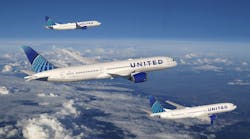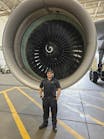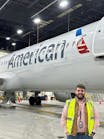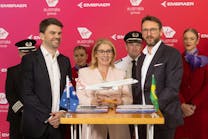United Buys Lots of Big Jets That Will Bring More Jobs to Newark Airport
United Airlines on Tuesday announced the largest order of Boeing 787 widebody jets by a U.S. carrier, along with hiring 15,000 more people nationally, including at least 2,000 more at Newark Liberty International Airport.
The massive order of widebody jets includes 100, 787 Dreamliners that will be delivered between 2024 and 2032 with the option to purchase 100 additional 787 widebodies to begin replacement of its fleet of 767 and 777 aircraft, the oldest of which is 30 years old, said Gerry Laderman, executive vice president and chief financial officer.
“This marks another big step in solidifying United Airlines position as the flag carrier of the United States and a leading airline around the globe,” said Scott Kirby, United CEO, during a media briefing.
The expansion comes on the heels of United’s largest purchase of 270 Boeing 737 MAX narrow body aircraft and 70 Airbus A321neo, announced at Newark airport on June 29, 2021 as part of the United Next expansion initiative.
In addition to the 787 order, United exercised options to purchase 44 more Boeing 737 MAX aircraft for delivery between 2024 and 2026. The airline also ordered an additional 56 more 737-MAX aircraft for delivery between 2027 and 2028.
While the 787 is not a stranger to Newark airport or United’s long distance and international routes, travelers can expect to see more of them moving forward, said Andrew Nocella, United’s Chief Commercial Officer and executive vice president.
“This is the largest widebody order by a U.S. carrier ever. The new order will replace the old 767′s used across the Atlantic and the South America starting in 2024,” he said.
The 767 fleet is expected to be retired by 2030.
“By the end of the decade the 767-300 and 400 which are popular in the New York areas will be replaced with these larger more fuel-efficient aircraft,” Nocella said.
The larger 787′s also allow United to grow at Newark despite the airport’s limited runway capacity, he said.
“The only way to grow is to replace smaller aircraft with larger aircraft and we’re well on our way to do that. What we see happen is fewer and fewer regional (small) jets… it makes sense to fly larger narrowbody aircraft...” he said.
The new fleet of 787′s will be accompanied by a wave of hiring to support the new aircraft and additional travelers, officials said. Nationally, United is looking to hire an addition 15,000 people, which includes 2,500 pilots, Laderman said.
United anticipates hiring a little over 2,000 additional employees at Newark airport in 2023, ranging from pilots to flight attendants and support people “above and below the wings,” Nocella said.
“We need more support to handle the larger aircraft,” he said.
A long haul jet that is expected to deliver better fuel economy and lower emissions, the 787 comes in three models and sized the 787-8, 9 and 10, Nocella said. Passenger capacity ranges from 248 people in a 787-8 to 336 passengers in the largest 787-10, according to Boeing. It also can haul more cargo.
While officials did not disclose the cost of the 787 fleet, a 150 plane order of Boeing 777-X jetliners by Emirates in 2013 was valued at $76 billion as of July 2021, however that order was reduced by 24 aircraft, said Simple Flying.
The continued trend of hybrid work weeks between a workplace and home is expected to generate more travel business by people who have more flexible schedules.
“What the new work pattern means is there is more flying occurring on off-peak days than weekends,” Nocella said. “This makes the operation out of our hub airports easier to manage. It will be great for customer operations particularly in Newark.”
When Newark airport’s new Terminal A opens in 2023, United will relocate some flights there from Terminal C.
“We’ll move a significant number of narrow body flights out of Terminal C to the new Terminal A and we’ll move what is remaining of our regional jets from Terminal A to C,” Nocella said. “That alone is going to decrease the pressure on Terminal C. It’s a great enhancement for the customer.”
United expects to operate 100 flights per day from the new Terminal A when it is fully operational, he said.
Our journalism needs your support. Please subscribe today to NJ.com.
Larry Higgs may be reached at [email protected].
©2022 Advance Local Media LLC. Visit nj.com. Distributed by Tribune Content Agency, LLC.



